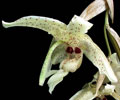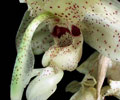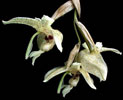|
|
|
|
|
| |
Flasks of
Stanhopea florida 'MC1906' × self |
|
| |
|
|
| |
| Number: |
TN3455 |
| Name: |
Stanhopea florida 'MC1906' × self
|
| Type: |
self (What's that?) |
|
Seed Donor: |
Dale Borders
|
|
Click to Enlarge

Pod Parent Flower |
Click to Enlarge

Pod Parent Closeup of Labellum |
Click to Enlarge

Pod Parent Inflorescence |
|
|
|
| |
Culture Notes from Donor: Parent plant: Temperature range I (60-83°F)
Comments: Parent plant: Flowers scented of mint/dust.
For additional origin/habitat information supplied courtesy of
Charles and Margaret Baker, see further below, near the bottom of this page.
|
Temperatures we attempt to use in the lab & greenhouse:
| For Species: |
|
Spring, Summer, Autumn, Winter: days average 75°F, nights 58°F; best fit is Cool-Intermediate 75-58°F
(Source:
Baker's Web OSC) |
|
About the name...
| Etymology of |
florida |
|
From Latin "floridus" with flowers.
(Source:
Mayr & Schmucker 1998) |
| Etymology of |
Stanhopea |
|
In honor of Philip Henry, 4th Earl of Stanhope, president of the London Medico-Botanical Society during the early part of the 19th century.
(Source:
Pridgeon 1992) |
| Pronunciation of |
florida |
|
FLO-ri-da
(Source:
Hawkes 1978) |
| Pronunciation of |
Stanhopea |
|
stan-HOPE-ee-ah
(Source:
Pridgeon 1992) |
|
If you would like to direct someone to this web page, please copy and paste this URL into your email:
http://troymeyers.com/d?013455
| Flask Information |
| Availability: |
We have sold all of the flasks for this item. |
| You should: |
Consider getting individual plants or compots instead of a flask.
You can place a "Notify Flask Recipients" Request, and either we or a flask recipient may contact you when plants are available.
You may also place a "Notify Retries" Request, and if an identical pollination (the same parents) is done again, we'll let you know.
You may reserve a flask, but it's very unlikely you'll get one ...this could only happen if we found a flask that we didn't know we had. |
| Yield Estimate: |
370 plants (based on flask surveys done 12/11/2003 )
|
| Plantlet Sizes: |
From many flasks 3 - 60 mm plants (based on flask surveys done 12/11/2003 through 05/03/2004)
From one most recently surveyed flask 30 - 55 mm (05/03/2004)
|
|
You might also want to:
|
View the seed assay for this item.
View items of the same species.
View items of the same genus.
|
| Ordering Information |
| You are not currently logged in. |
|
You must be a registered user and be logged in to reserve a flask or place a notification request. Please log in:
|
|
|
|
|
|
| |
The origin/habitat information below is supplied courtesy of Charles and Margaret Baker
The following information is based on the name of the plant provided by the donor, and assumes that the name is correct. If the plant has been misidentified, then the following information may not be correct.
This text is copyrighted by the Bakers and may not be reproduced without permission.
ORIGIN/HABITAT: Eastern and southwestern Ecuador and northern Peru on the
eastern slopes of the Andes at 3300-5900 ft. (1000-1800 m). In Ecuador,
plants have been collected in Canar Province near Asumción, between Cuenca
and Pasaje at 3300 ft. (1000 m), in Tungurahua Province at Rio San
Franciso 5 km west of Rio Negro between Baños and Puyo at 4900 ft. (1500
m), and in Zamora-Chinchipe at mile 30 (km 49) between Loja and Zamora at
4250 ft. (1300 m). Plants are epiphytic in seasonally dry mountain cloud
forest.
More about this information and the Bakers...
|
|
|
| |
|
|
|